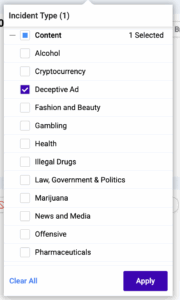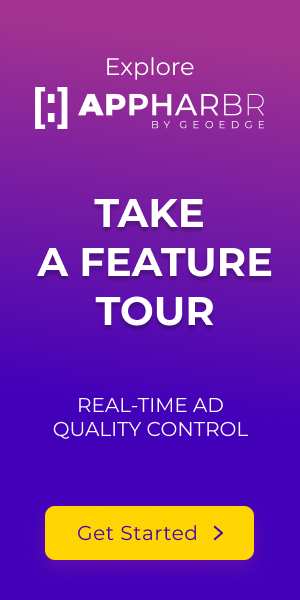Deceptive ads have become a tricky yet important issue for developers to confront. These are creatives that may lack integrity, be intentionally or unintentionally deceiving, and contain misleading UI components. Deceptive ads are not malicious, but the fact that they often appear indistinguishable from malicious clickbait is why the issue has become such a challenge for developers. These trust-eroding ads are not the same as clickbait ads, which are inherently malicious, served by scammers, and have the goal of leading users to some sort of scam. Deceptive ads are designed to mislead users through urgent, exaggerated claims. Whether it’s intentionally misleading or just poor execution, they have rapidly emerged as one of the most pervasive threats facing mobile publishers and app developers today.
In this post, we’ll unpack how deceptive ads navigate through the complex programmatic ecosystem, reveal critical weaknesses of traditional ad-quality approaches, and demonstrate why proactive solutions like AppHarbr’s real-time ad quality control offer the most reliable line of defense.
The Rise of Deceptive Ads: An Escalating Threat to Mobile Publishers
Mobile publishers and app developers are facing a sophisticated threat landscape, with deceptive ads positioned as one of the fastest-growing risks. Designed explicitly to hook users with an enticing promise or cleverly disguised interfaces, these ads infiltrate otherwise carefully curated app environments. What makes deceptive ads especially difficult to manage is their effectiveness, leveraging psychological triggers such as urgency, fearmongering, and mimicry of trusted UI elements to provoke user interaction. They also lean heavily on being vague or misleading, overpromising what the user gets out of interacting with the ad.

This meticulous deception damages user trust, contributes directly to churn, and erodes customer lifetime value, ultimately hitting publishers’ bottom lines hard. Recent advancements in malvertising techniques exacerbate this issue, with fraudsters skillfully navigating loopholes within the highly fragmented mobile advertising ecosystem.
As these malicious creatives successfully bypass traditional blocking methods, app monetization teams grapple with compromised ad quality, regulatory exposure, and a deteriorating end-user experience. While developers are becoming aware of the issue, tackling it is still a practical challenge for many. For developers relying on manual QA to sort through problematic creatives, these can be especially difficult to detect due to their inconspicuous nature. Additionally, they’re not always malicious, and so the lack of glaring security threats can make it even more difficult to detect that there’s anything to be concerned about within a deceptive ad creative. For publishers responsible for millions of monthly impressions, even a limited presence of deceptive ads can translate quickly into consequences for the business.
Decoding Deceptive Ads: Key Tactics Fraudsters Exploit
Advertisers use questionable practices when developing deceptive ads that leverage intricate psychological and design techniques to trick users into unintended actions, often slipping through basic quality checks.
Common examples of deceptive ads include:
- Exploiting urgency and fearmongering
- using alarming messages such as “Your device is infected” or “You have (X) viruses—tap now to clean”
- Misleading call-to-action
- Elements structured to be simplistic yet ambiguous phrases like “Start Test” or “Continue Free”
- Exaggerated claims and deliberate vagueness
- Ambiguous phrasing such as “Speed up your phone instantly” or “Boost performance with one click”
The goal of using these social engineering tactics is often to boost engagement and click-through rate with the creative, but can also lean in the direction of malicious activity. Regardless, they’re disruptive to user experience, which can have negative effects on LTV and publisher reputation.

Moreover, fraudsters have become increasingly adept at mimicking trustworthy interfaces. By mirroring operating system notifications, well-known apps, or popular sites, deceptive ads gain credibility and manipulate user trust. Users mistakenly assume legitimacy—thinking they’re interacting with a system message or known interface—and inadvertently engage with deceptive flows, undermining publisher transparency and compromising brand integrity. These distinct yet overlapping tactics are explicitly engineered to bypass standard manual checks and rudimentary platform-level validation methods. Publishers who recognize these techniques can better appreciate the precision and real-time sophistication required to proactively detect and mitigate deceptive creatives in their inventory.
Inside the Programmatic Maze: Why Deceptive Ads Slip Through the Cracks
The programmatic ecosystem powering mobile advertising is notoriously fragmented and opaque, creating a perfect environment for deceptive ads to infiltrate undetected. Publishers cannot rely on SSPs and networks to block all unwanted advertising, as they are simply not equipped with the tools to do so in real time and to scale. Within such a complex web of intermediaries, critical information about creatives is often diluted, delayed, or absent, drastically reducing publishers’ visibility and control over their ad experiences.
Within the multiple layers of programmatic advertising, validation checks from various platforms frequently lack depth and precision, allowing deceptive ads to persist. SSPs and networks don’t have the motivation nor the tools to block ads unless they are malicious. So whenever an ad is borderline-deceptive but not malicious, they will allow it. And when their mediation systems render insufficient, the result is increased churn and poor app ratings.
Why Traditional Ad QA and Mediation Platforms Aren’t Enough
Traditional approaches to ad quality, primarily manual QA teams and basic mediation-platform checks, are not a practical solution to the nuanced issue of deceptive ads. Manual review simply can’t scale to detect deceptive creatives appearing through billions of impressions. Meanwhile, mediation platforms typically lack the nuanced ability to detect sophisticated deception techniques. To safeguard their inventory at scale, publishers require dedicated, real-time solutions capable of proactively identifying misleading ads with absolute precision and automated speed.
How AppHarbr Detects and Neutralizes Deceptive Ads at Scale
AppHarbr delivers proactive intelligence and real-time ad-quality management at enterprise scale. Its advanced AI-driven image recognition and pattern analysis quickly identify deceptive tactics at the pre-impression level. Continuous machine-learning improvements provide immediate blocking of nuanced deceptive tactics, offering a unified ad-quality defense system across all platforms, SSPs, and mediation solutions. Operating at the speed publishers require, AppHarbr intercepts deceptive ads within milliseconds, eliminating latency gaps and equipping publishers with robust, real-time ad-quality safeguards.

Protect Your Revenue and Reputation: Ensuring Ad Quality
Deceptive ads are a substantial financial and reputational threat—one that proactive ad-quality management from AppHarbr resolves. Real-time detection and blocking preserve user experience, reduce churn, and maintain the reputation and standing of your app. AppHarbr transforms ad quality from reactive troubleshooting into strategic, proactive revenue protection, giving publishers control over their inventory and reputation.
Get Ahead of Deceptive Ads Today with AppHarbr
Waiting until deceptive ads inflict damage is no longer a risk publishers can afford to take. AppHarbr proactively blocks malicious creatives, protecting their brand, users, and bottom line. Move beyond ineffective manual QA and fragmented mediation platforms. Integrate AppHarbr’s advanced, enterprise-ready ad solutions today.
Ready to proactively protect your app from deceptive ads? Connect with AppHarbr now and discover how seamlessly our solution can integrate with your workflows, secure your revenue, and ensure your enterprise stays ahead of emerging threats.




